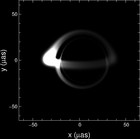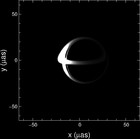

Odele Straub, Frederic H. Vincent, Marek A. Abramowicz, Eric Gourgoulhon, Thibaut Paumard calculate the “observed at infinity” image and spectrum of the accretion structure in the Galactic centre, Sgr A*, by modelling it as an optically thin, constant angular momentum ion torus in hydrodynamic equilibrium. The figure shows images of such an ion torus around Sgr A* as seen from Earth. Confined by the innermost ultra-fine ring of light is the so called black hole silhouette. Left: moderate black hole spin (a_* = 0.5). Right: high black hole spin (a_* = 0.9).
The Galactic Centre is one of the most interesting regions for scientific investigation because it is the closest available galactic nucleus and, therefore, can be studied with resolutions that are impossible to achieve with other galaxies. The radio source Sagittarius A* (Sgr A*) is associated with the supermassive black hole at the centre of our Galaxy. Given the Sgr A* mass and distance, the Schwarzschild radius corresponds to an angular size of around 10 μas in the sky, making the Galactic Centre black hole an ideal candidate for direct observation by near-future sub-mm VLBI instruments.
In this context we have been interested in calculating the size and shape of the “black hole silhouette” cast by the black hole on the accretion structure. The black hole silhouette is determined by the photon orbit and depends thus only on black hole mass and spin. Therefore, with the known black hole mass in the Galactic Centre the spin could be estimated from fitting the calculated size and shape of the shadow to the size and shape observed. The looks (spatial extent, shape, brightness distribution, etc.) of the entire image, however, depend not only on black hole mass and spin but also on the details of the accretion structure around Sgr A*. Most of them are uncertain, e.g., the chemical abundance, the radiative processes, the inclination. They have not been sufficiently examined yet, and a wide range of the relevant parameter space remains unexplored.
We employ the simple analytical model of ion tori (based on the mathematical description of Polish doughnuts, introduced by Paczynski and collaborators) to explore the parameter space of the accretion structure around Sgr A* and calculate the observed images and spectra numerically using the ray-tracing code GYOTO. Our results demonstrate that the ion torus model is able to account for the main features of the accretion structure surrounding Sgr A*.






